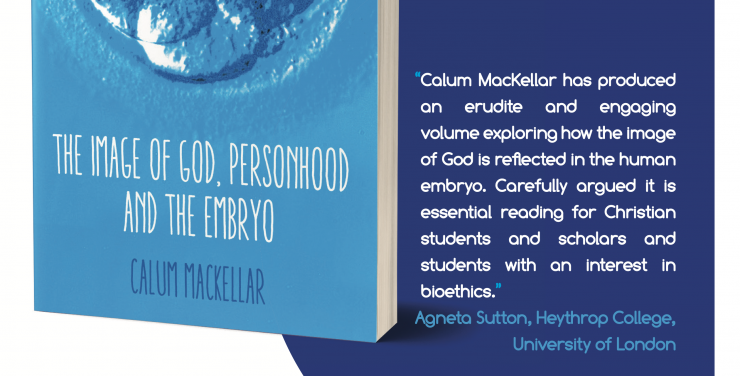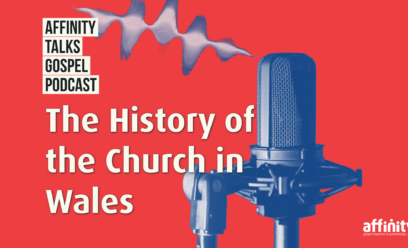Book review: The Image of God, Personhood and the Embryo

The latest issue of Affinity’s Social Issues Bulletin is out now. It is free to download, as are all previous editions. One of the articles is a review by John Ling of a book on the image of God in human beings by Calum MacKellar.
Book review: The Image of God, Personhood and the Embryo
The Image of God, Personhood and the Embryo
Calum MacKellar
SCM Press, 270pp, 2017, £29.99 (Amazon)
The purpose
Genesis 1:27 is the fundamental of biblical bioethics. On that verse hangs our understanding and regard for the human embryo. The image of God and early human life have typically been treated as two disparate topics, theological or biological. In this book, Calum MacKellar seeks to connect them. He states his reason (p. vii) as, ‘… because a specific and detailed examination of how the image of God may be reflected in the embryo seemed to be missing from the accumulated heritage of Christian study’. He also wants to equip pastors to teach their congregations about related and discomforting issues, such as infertility, miscarriage and abortion. That is an admirable ambition. Furthermore, he anticipates a practical response (p. x), ‘… if the claims being made [in this book] are correct and embryonic human lives can be considered as being made in the image of God, then the deliberate destruction of these countless embryos represents the deliberate destruction of those whom God loves very deeply’. That is a most laudable call to action.
The content
Part I, the opening quarter of the book, presents a brisk overview of historic and current thinking about the moral status of the embryo, the image of God and personhood.
First, concerning the moral status of the embryo, MacKellar is adamant (p. 7), ‘… from the restricted viewpoint of science, embryos… are only collections of cells destined to become, with time, collections of dust or ashes. This means that the worth and value of an embryo cannot be demonstrated from a scientific perspective and any moral appreciation becomes impossible. It is only because of the manner in which God, the only true source of value, chooses to consider this being that it has any worth and deserves to be recognised with moral status. This is the real challenge for modern societies as they struggle to evaluate the embryo from a secular moral perspective.’
What follows is a survey of human embryology, from the ancient views of Plato and Aristotle, those of the Church Fathers, a lengthy discussion of Exodus 21: 22-25, through to the more recent opinions of men, such as Paul Ramsey and Oliver O’Donovan. The dénouement? Historically, the Church has generally cherished human embryos and consistently opposed their deliberate destruction. The great divide of the current protection-destruction debate depends upon (p. 26), ‘… an essentially empirical perspective based on observation and a perspective that seeks to understand the nature of the very being of the human…’
This is big talk and one of the major benefits of MacKellar’s work. Here is a conservative Christian and a former research scientist claiming that the world and its scientism have constructed a colossal bioethical mistake.
Second, though the image of God in the creation of human beings is stated explicitly only three times in the Old Testament, the implications are legion, including human attributes, such as the rational, relational and the creative. MacKellar takes the vastest view and embraces them all while admitting that the reality is unfathomably more. Moreover, after examining various topics, he settles his thesis by insisting that the image of God is present in the earliest of human embryos.
Third, personhood is a more contentious and trickier concept to grasp. Here vague notions like ‘the right to life’, ‘the body-soul duality’, ‘when does human life begin?’ and ‘are persons and individuals synonymous?’ arise and are shown to cloud the issue. MacKellar plumps for personhood appearing in the earliest embryo because, you are a soul, not you have a soul, or as Barth stated, ‘man is embodied soul and besouled body’. Thus, personhood is about being, not about completing a tick box of attainments. Herein is the theological understanding of personhood as both unitary and mysterious substance versus its biological understanding of raw material with attributes.
Part II, the remaining three-quarters of the book, is a more detailed rehearsal of the themes of Part I. The first two sub-sections on creation and the incarnation are the pre-eminent.
MacKellar tackles creation in general and creation of mankind in particular. He insists, because both occur ex nihilo and without any necessity, they are therefore marked by God’s love. He declares (p. 88), ‘… each and every human person is created from, and represents, both the beautiful unity of all three persons of the Trinity and also the amazing love that binds them in communion’ and (p. 90), ‘How this creation of every child by God takes place will always remain a mystery’… ‘In other words, these new beings will in some way continue to reflect the image of God because he created them.’ See, the bond between the image of God and the human embryo is resolutely forged.
Then comes the enormity of the incarnation, fittingly the longest chapter of the book. MacKellar displays it as ineffable. While the incarnation of Jesus Christ as man remains the best Scriptural reply to the question, when does human life begin? MacKellar takes it to another level. It is, ‘… the reality that Christ became fully human in all defining dimensions of humanity, including its pre-natal aspects’ (p. 139). In other words, the creator becomes the paradigm human being. But it was the Father’s love that sent his Son. And by the Spirit, believers are the recipients of that Triune love. Grasp that and suddenly the incarnation of the embryonic Christ blossoms with love, creation and human dignity. How we stupidly downplay the stupendous event!
The downsides
Every book has its downsides and this one is no exception. There is no getting away from it – this is a difficult book to read. Of course, the subjects are complex and at times brain-achingly so. This is not helped by the author’s rather heavy and repetitious style – there is no relief by way of anecdotes, analogies or witticisms. Instead there are recurring themes and reminders that not all topics will be fully covered. These criticisms betray the book’s poor structure – a good copy editor would have had a radical field day and produced a better book.
The book’s style is also somewhat unexpected. Citations abound – there are over 900 in total. It could be regarded as a collection of quotations held together by comments from the author – but that would be too unkind.
Dr Calum MacKellar is currently the director of research at the Scottish Council on Human Bioethics, Edinburgh and an elder in the Church of Scotland. And his Scottish roots show through. For example, there are some two dozen extracts from the writings of the Scottish theologian Thomas Torrance, numerous statements from various Reports of the Church of Scotland and several notes by other learned men and women from North of the border. Is this balance or bias? And, yes, all writers have distracting tics, such as MacKellar’s use of the word ‘interestingly’ – it opens sentences at least a dozen times! Finally, the cost of this modest-sized paperback, at £35, will deter many potential readers. Nevertheless, let it be known that I found the book sufficiently instructive that I purchased and donated a copy for the library of the London Seminary.
The upsides
Notwithstanding these complaints, MacKellar expounds some truly wonderful major themes that undoubtedly add to conservative Christian understanding of what it means to be a human being. He also tackles some minor, but not unimportant, themes of twenty-first-century embryology. For instance, he unpicks the tangled thinking associated with embryonic status and the processes of twinning and recombination (p. 202). And there is an Appendix entitled The Moral Status of New Kinds of Embryos. For those readers perplexed by hybrids and cybrids, as well as other novel human formats, MacKellar’s Appendix is helpful. Overall, he invokes the precautionary principle and concludes that all such beings should be given the benefit of the doubt and therefore shielded by the full protective position (p. 240).
In conclusion
Since quotations are currently à la mode, here is a practical one (p. 39) from Calvin’s Institutes that encompasses something of MacKellar’s remit, ‘We are not to consider that men merit of themselves but to look upon the image of God in all men, to which we owe honour and love… Therefore, whatever man you meet who needs your aid, you have no reason to refuse to help him.’
John Ling is a freelance speaker, writer and consultant bioethicist. He is the author of three books on bioethical issues. He regularly updates his personal website.
(This article was originally published in the Affinity Social Issues Bulletin for February 2021. The whole edition can be found at www.affinity.org.uk)
Stay connected with our monthly update
Sign up to receive the latest news from Affinity and our members, delivered straight to your inbox once a month.



